Effect of Adding Carbon Nanotubes on the Freeze-Thaw and Thermal Fatigue Resistance of Latex Modified Mortar
Abstract
:1. Introduction
2. Experimental Program
2.1. Specimens’ Preparation
2.2. Freeze-Thaw and Thermal Fatigue Cycles
2.3. Physical and Mechanical Evaluations
3. Results and Discussion
3.1. Effect of CNTs Content on Compressive and Tensile Strengths
3.2. Effect of CNTs Content on Shrinkage over Time
3.3. Effect of CNTs Content on Flexural Behavior
4. Conclusions
- Freeze-thaw cycles adversely affect the compressive strength of LMM specimens due to the rapid development of microcracks in the first 150 cycles. The effect of freeze-thaw cycles is stabilized in the following 150 cycles, leading to relative rebound in the compressive strengths. The effect of thermal fatigue cycles is less pronounced on the compressive strength of different LMM specimens.
- Contrary to the compressive strength, the effect of freeze-thaw and thermal fatigue cycles on the tensile strength of LMM specimens was limited. This could be attributed to the difference in the failure mechanism of LMM specimens in compression and tension.
- It is apparent that adding CNTs improved the thermal resistance and freeze and thaw resistance of the produced LMM in compression. The role of CNTs here is evident in limiting the drop in compressive strength after the exposure to 150 cycles of freeze-thaw cycles and increasing the regain in compressive strength after the exposure to 300 cycles of freeze-thaw cycles. The CNTs effect is less evident in improving the compressive strength with thermal fatigue cycles.
- Large effect of using CNTs for improving the tensile strength of LMM specimens that were subjected to thermal fatigue cycles is observed. Similar improvements in tensile strength are observed for LMM specimens subjected to freeze-thaw cycles. By adding 1.5% CNTs, the improvements in the tensile strength reached 59% after the exposure to 300 cycles of thermal fatigue and 12% after the exposure to 300 cycles of freeze-thaw. The improvements in tensile strength could be attributed to the CNTs bridging effect. The bridging effect is supported by the friction and the noncovalent bond between the nanotubes and surrounding latex.
- Adding CNTs results in improvement in compressive strength and tensile strength of LMM. Improvement in tensile strength is due to bridging.
- The use of CNTs in LMM mixtures does not alter the shrinkage strains developed at LMM specimens when exposed to freeze-thaw or thermal fatigue cycles. However, they contribute in stress transfer as noticed in the compression and tension test results.
- Adding CNTs increased the flexural load carrying capacity and ductility of LMM specimens subjected to freeze-thaw cycles. Such improvements are found to be in line with the improvements in the tensile strength observed after conducting the splitting tension test.
Acknowledgments
Author Contributions
Conflicts of Interest
References
- Ohama, Y. Handbook of Polymer-Modified Concrete and Mortars: Properties and Process Technology; William Andrew: Norwich, NY, USA, 1995. [Google Scholar]
- ACI Committee 548. ACI 548.3R-09: Report on Polymer-Modified Concrete; ACI Committee: Farmington Hills, MI, USA, 2009. [Google Scholar]
- Sun, W.; Zhang, Y.M.; Yan, H.D.; Mu, R. Damage and Damage Resistance of High Strength Concrete Under the Action of Load and Freeze-Thaw Cycles. Cem. Concr. Res. 1999, 29, 1519–1523. [Google Scholar] [CrossRef]
- Mu, R.; Miao, C.; Luo, X.; Sun, W. Interaction between Loading, Freeze-Thaw Cycles, and Chloride Salt Attack of Concrete with and without Steel Fiber Reinforcement. Cem. Concr. Res. 2002, 32, 1061–1066. [Google Scholar] [CrossRef]
- Cai, H.; Liu, X. Freeze-Thaw Durability of Concrete: Ice Formation Process in Pores. Cem. Concr. Res. 1998, 28, 1281–1287. [Google Scholar] [CrossRef]
- Jacobsen, S.; Sellwvold, E.J. Self healing of high strength concrete after deterioration by freeze/thaw. Cem. Concr. Res. 1996, 26, 5–62. [Google Scholar] [CrossRef]
- Jacobsen, S.; Gran, H.C.; Sellevold, E.J.; Bakke, J.A. High strength concrete—Freeze/thaw testing and cracking. Cem. Concr. Res. 1995, 25, 1775–1780. [Google Scholar] [CrossRef]
- Gasman, L. Nanotechnology Applications and Markets; Artech House, Inc.: Norwood, MA, USA, 2006. [Google Scholar]
- Lee, J.; Mahendra, S.; Alvarez, P.J.J. Potential environmental and human health impacts of nanomaterials used in the construction industry. In Nanotechnology in Construction 3; Springer: Berlin/Heidelberg, Germany, 2009; pp. 1–14. [Google Scholar]
- Salemi, N.; Behfarnia, K.; Zaree, S.A. Effect of nanoparticles on frost durability of concrete. Asian J. Civ. Eng. 2014, 15, 411–420. [Google Scholar]
- Tyson, B.M.; Abu Al-Rub, R.K.; Yazdanbakhsh, A.; Grasley, Z. Carbon nanotubes and carbon nanofibers for enhancing the mechanical properties of nanocomposite cementitious materials. J. Mater. Civ. Eng. 2011, 23, 1028–1035. [Google Scholar] [CrossRef]
- Sobolkina, A.; Mechtcherine, V.; Khavrus, V.; Maier, D.; Mende, M.; Ritschel, M.; Leonhardt, A. Dispersion of carbon nanotubes and its influence on the mechanical properties of the cement matrix. Cem. Concr. Compos. 2012, 34, 1104–1113. [Google Scholar] [CrossRef]
- Wang, X.; Rhee, I.; Wang, Y.; Xi, Y. Compressive Strength, chloride permeability, and freeze-thaw resistance of MWNT concretes under different chemical treatments. Sci. World J. 2014, 2014. [Google Scholar] [CrossRef] [PubMed]
- Li, W.W.; Ji, W.M.; Wang, Y.C.; Liu, Y.; Shen, R.X.; Xing, F. Investigation on the mechanical properties of a cement-based material containing carbon nanotube under drying and freeze-thaw conditions. Materials 2015, 8, 8780–8792. [Google Scholar] [CrossRef] [PubMed]
- Cwirzen, A.; Habermehl-Cwirzen, K. The effect of carbon nano-and microfibers on strength and residual, cumulative strain of mortars subjected to freeze-thaw cycles. J. Adv. Concr. Technol. 2013, 11, 80–88. [Google Scholar] [CrossRef]
- Konsta-Gdoutos, M.S.; Metaxa, Z.S.; Shah, S.P. Highly dispersed carbon nanotube reinforced cement based materials. Cem. Concr. Res. 2010, 40, 1052–1059. [Google Scholar] [CrossRef]
- Soliman, E.M.; Kandil, U.F.; Taha, M.M.R. A New Latex Modified Mortar Incorporating Carbon Nanotubes: Preliminary Investigations; ACI Special Publications; ACI: Farmington Hills, MI, USA, 2011; Volume 278. [Google Scholar]
- Soliman, E.M.; Kandil, U.F.; Taha, M.M.R. The significance of carbon nanotubes on styrene butadiene rubber (SBR) and SBR modified mortar. Mater. Struct. 2012, 45, 803–816. [Google Scholar] [CrossRef]
- Ma, P.C.; Siddiqui, N.A.; Marom, G.; Kim, J.K. Dispersion and functionalization of carbon nanotubes for polymerbased nanocomposites: A review. Compos. Part A Appl. Sci. Manuf. 2010, 41, 1345–1367. [Google Scholar] [CrossRef]
- Glatkowski, P.J.; Landrau, N.; Landis, D.H.; Piche, J.W.; Conroy, J.L. Conformal Coatings Comprising Carbon Nanotubes. U.S. Patent Application No. 7118693B2, 10 October 2006. [Google Scholar]
- Kim, Y.J.; Shin, T.S.; Choi, H.D.; Kwon, J.H.; Chung, Y.C.; Yoon, H.G. Electrical conductivity of chemically modified multiwalled carbon nanotube/epoxy composites. Carbon 2005, 43, 23–30. [Google Scholar] [CrossRef]
- Yurekli, K.; Mitchell, C.A.; Krishnamoorti, R. Small-angle neutron scattering from surfactant-assisted aqueous dispersions of carbon nanotubes. J. Am. Chem. Soc. 2004, 126, 9902–9903. [Google Scholar] [CrossRef] [PubMed]
- ASTM International. ASTM C39/C39M-16b, Standard Test Method for Compressive Strength of Cylindrical Concrete Specimens; ASTM International: West Conshohocken, PA, USA, 2016. [Google Scholar]
- ASTM International. ASTM C496/C496M-11, Standard Test Method for Splitting Tensile Strength of Cylindrical Concrete Specimens; ASTM International: West Conshohocken, PA, USA, 2004. [Google Scholar]
- ASTM International. ASTM C348-14, Standard Test Method for Flexural Strength of Hydraulic-Cement Mortars; ASTM International: West Conshohocken, PA, USA, 2014. [Google Scholar]


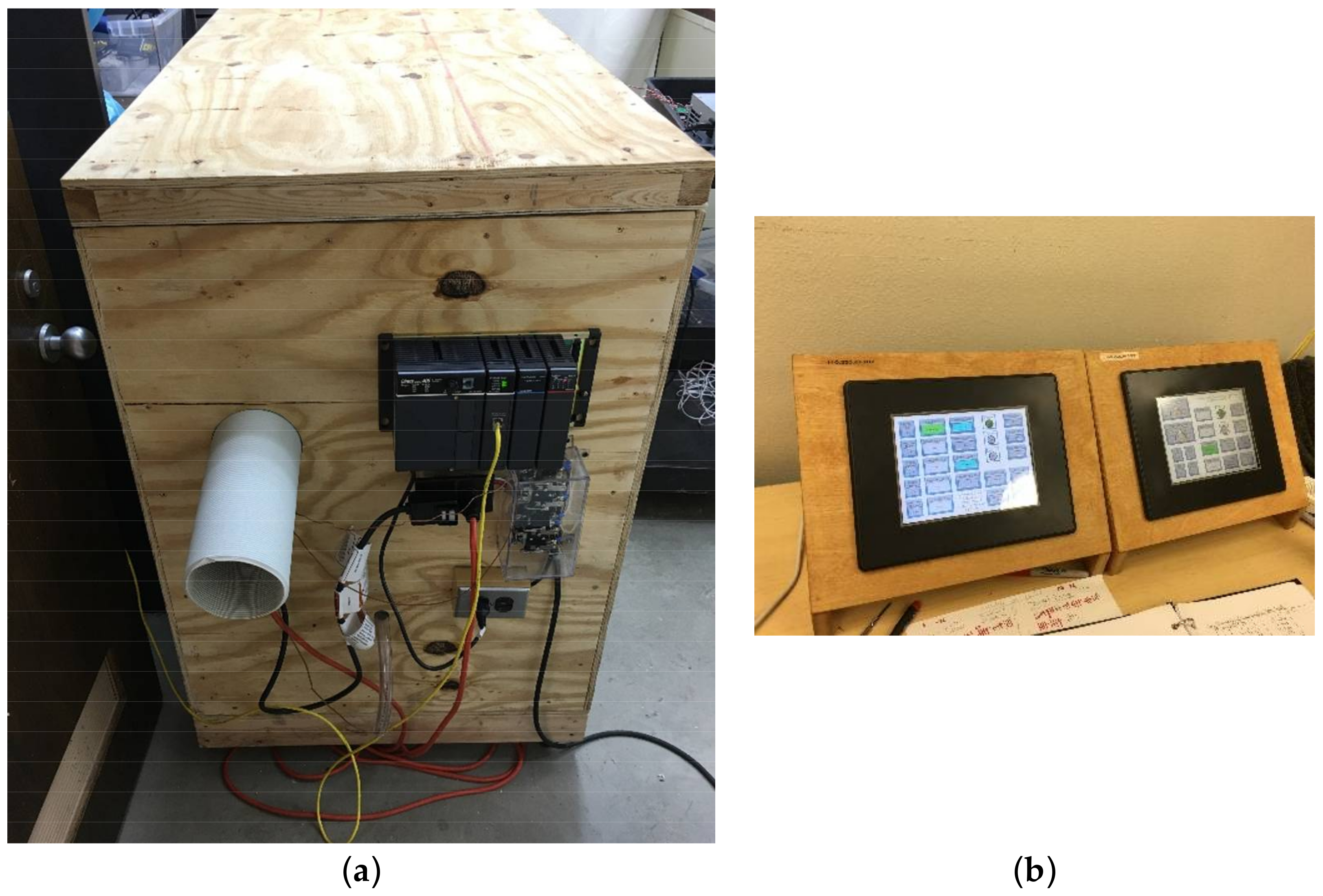

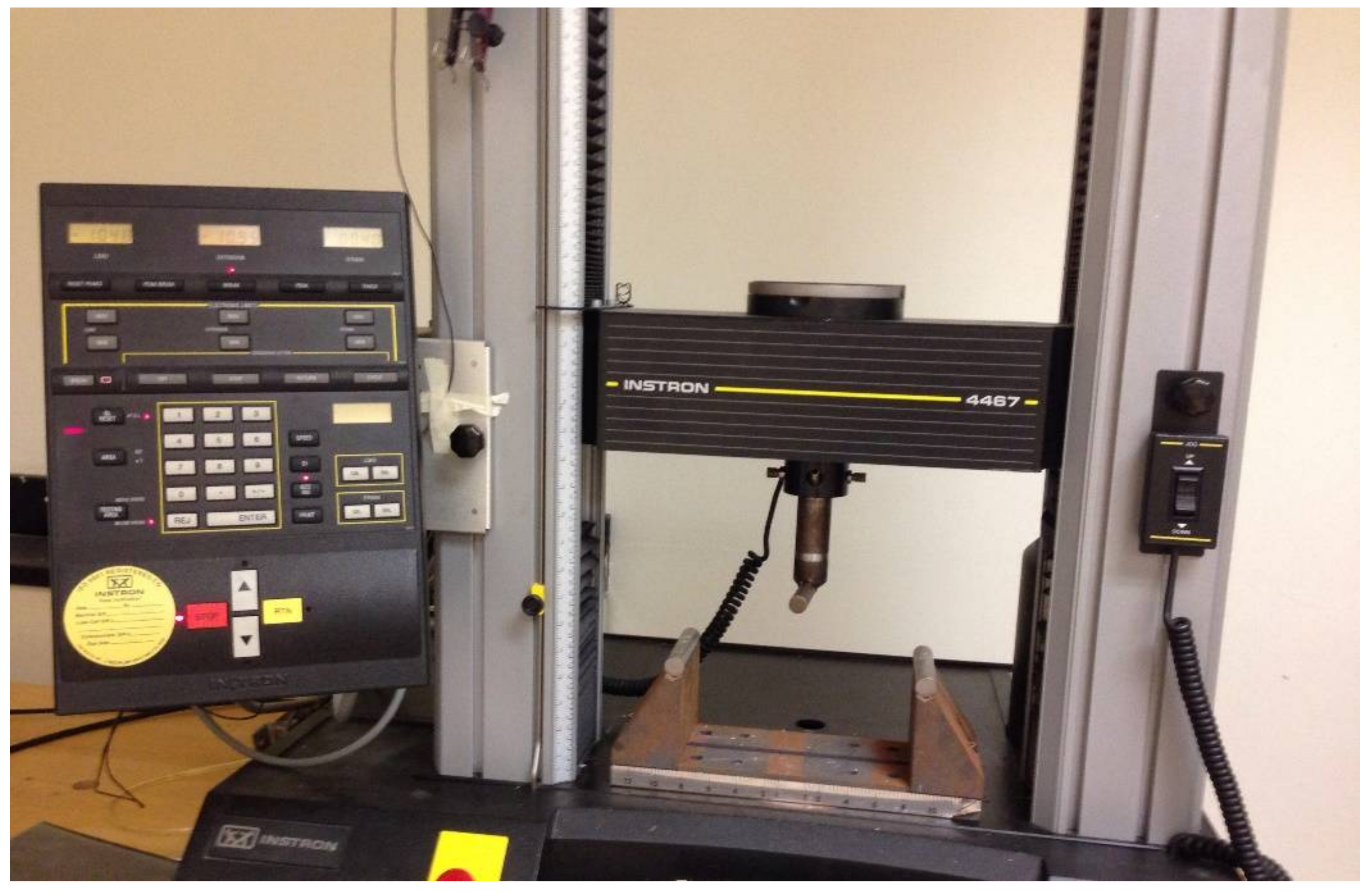
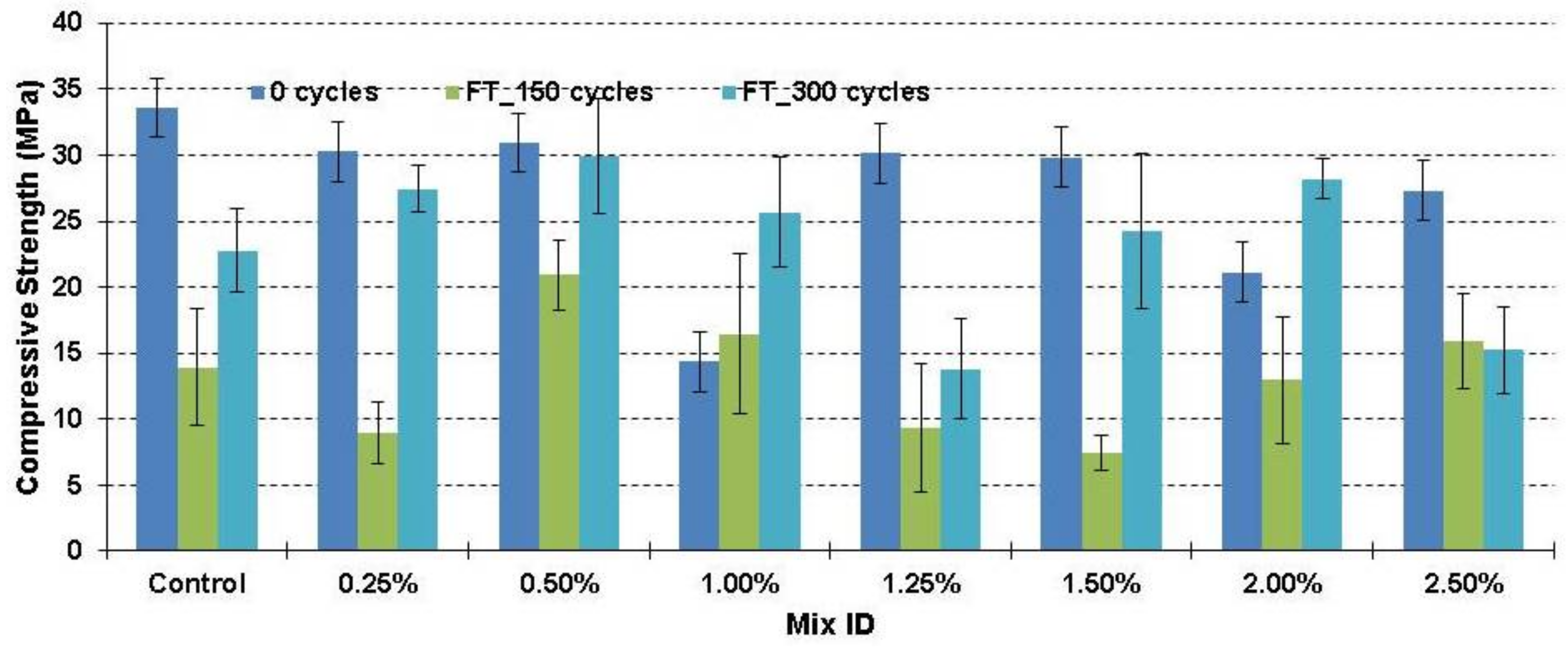
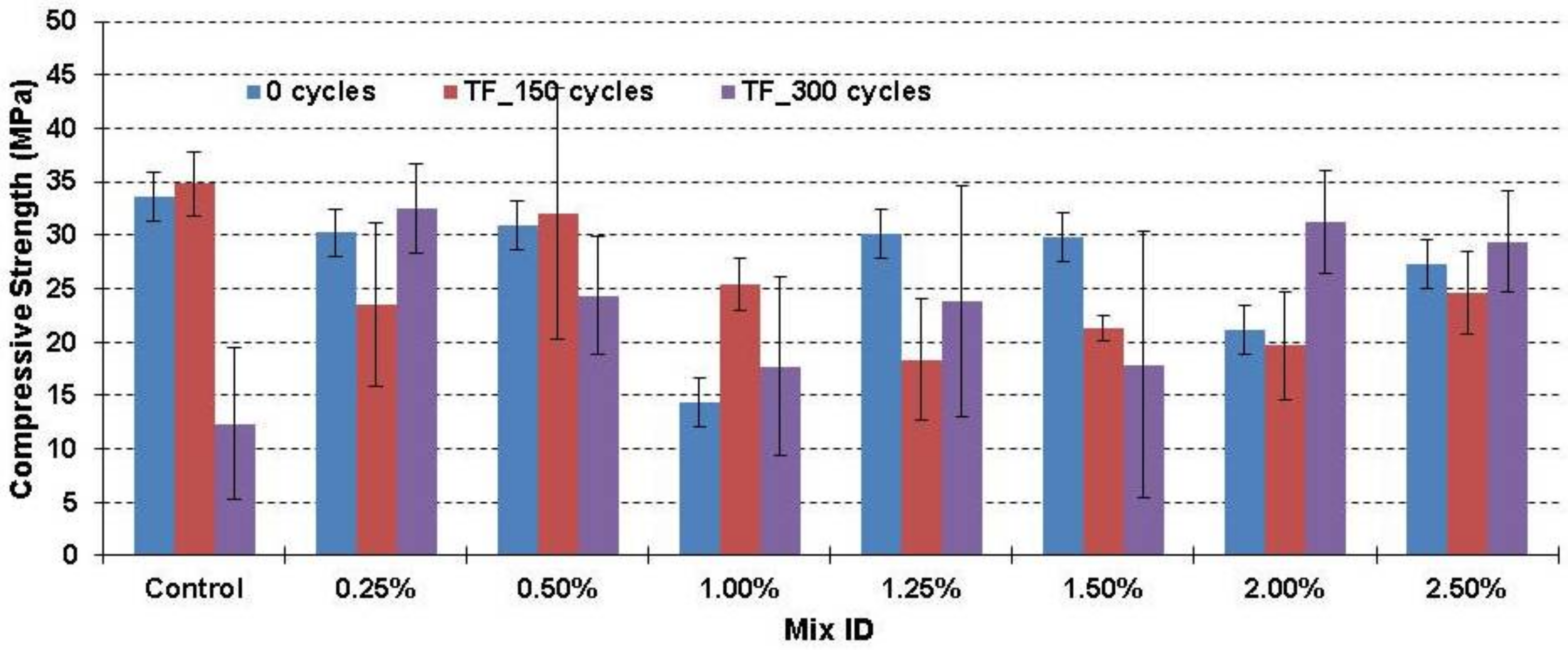
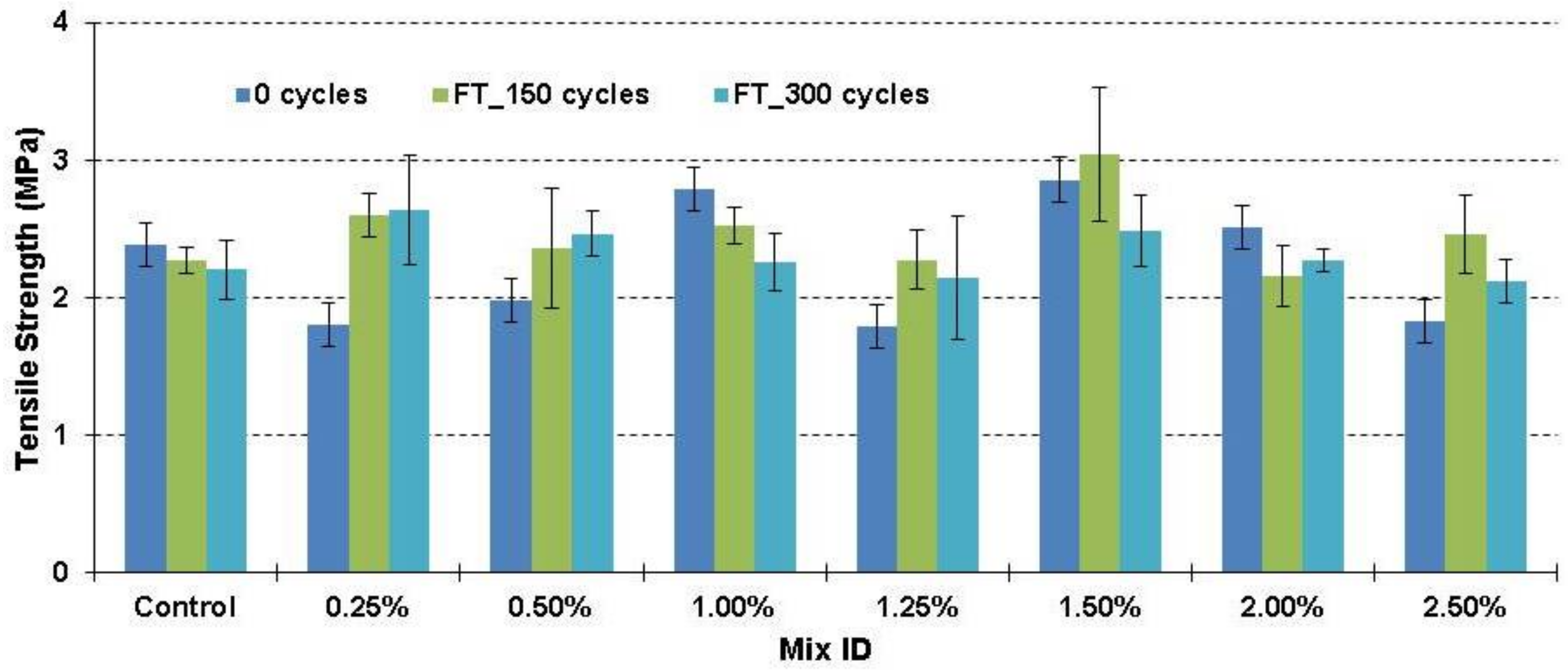
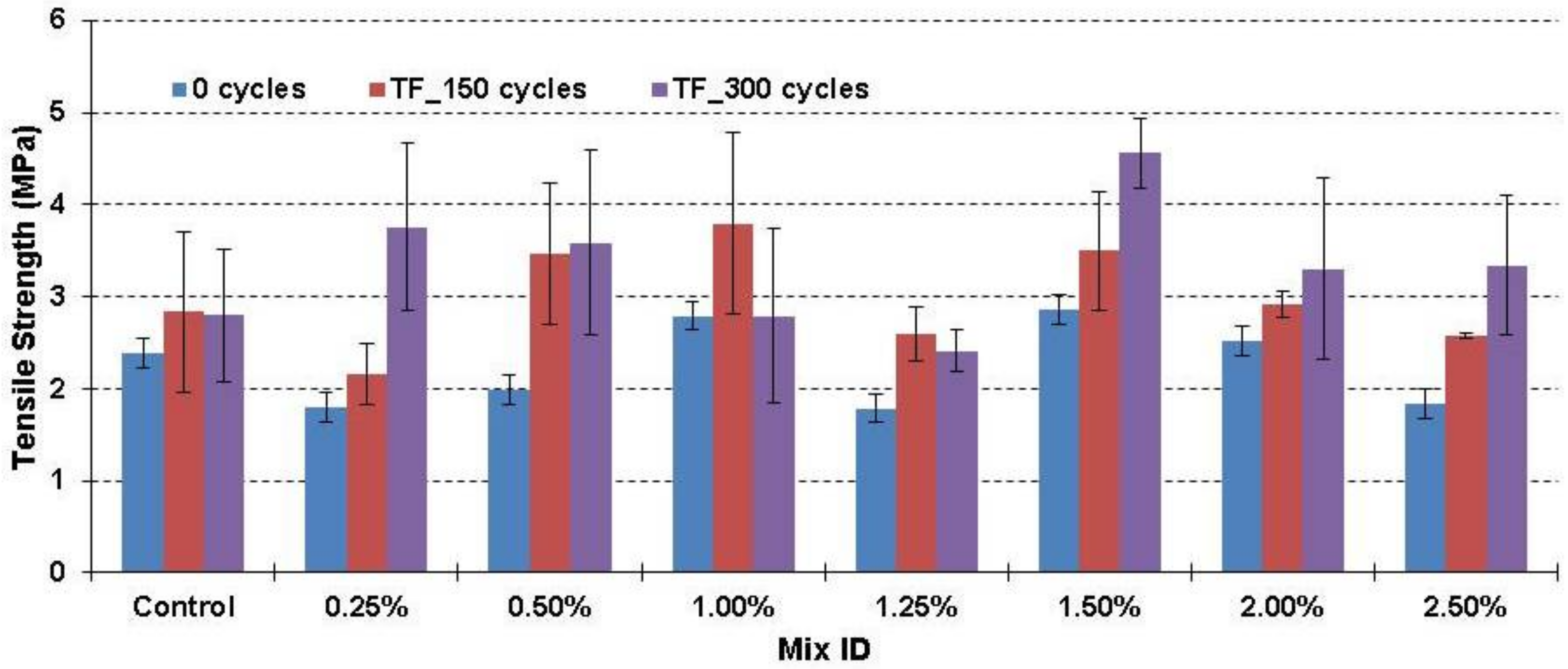
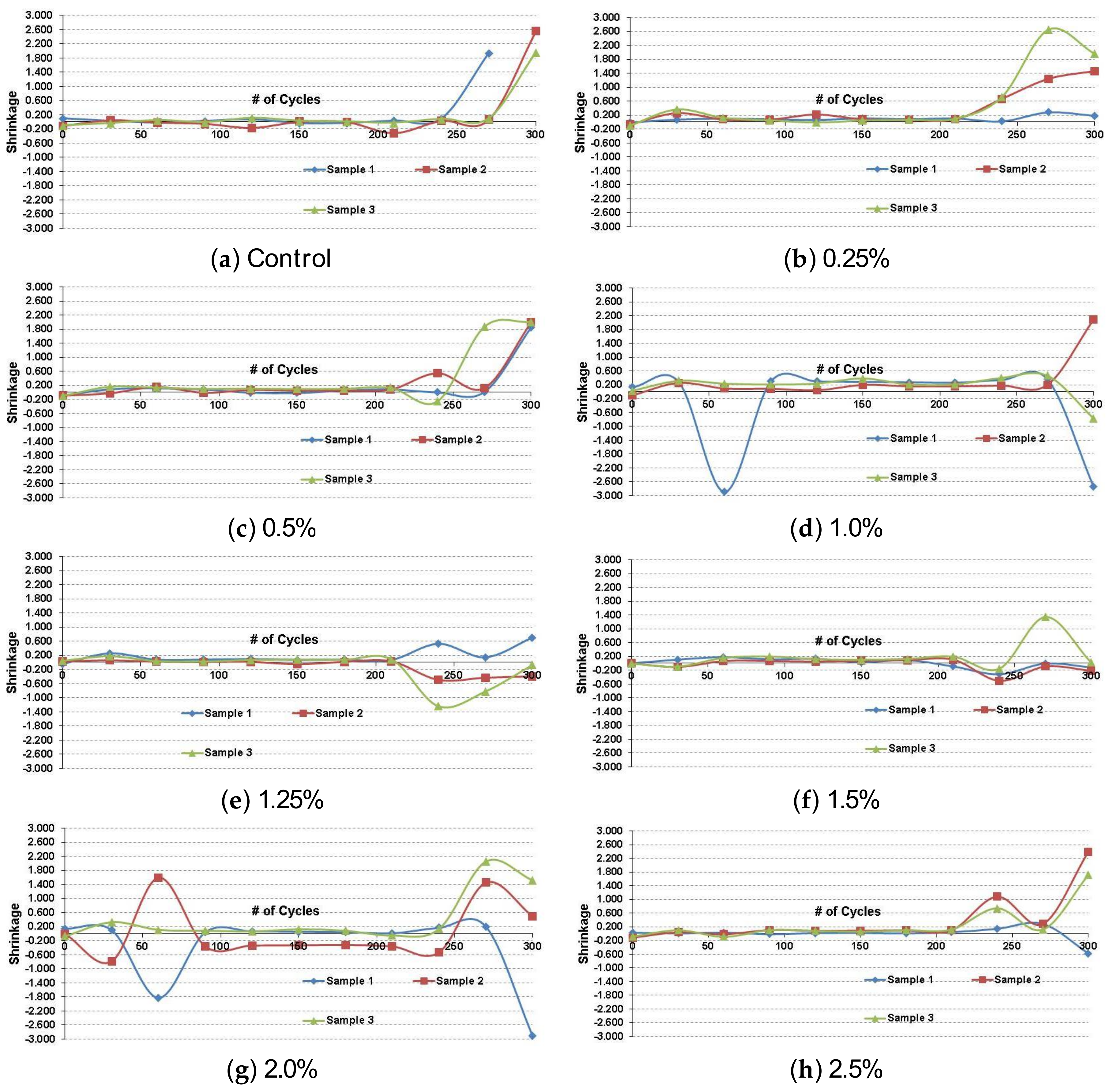

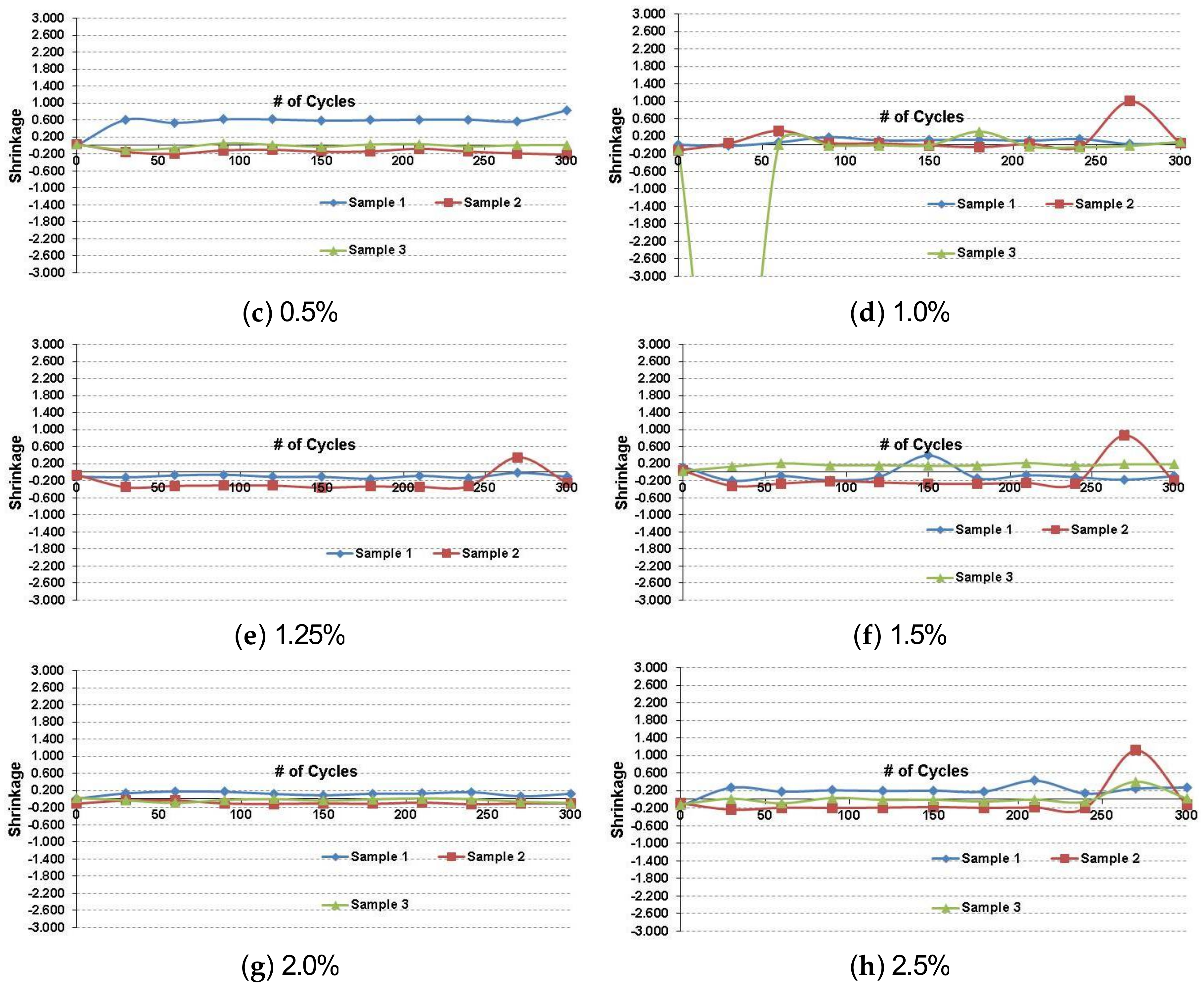
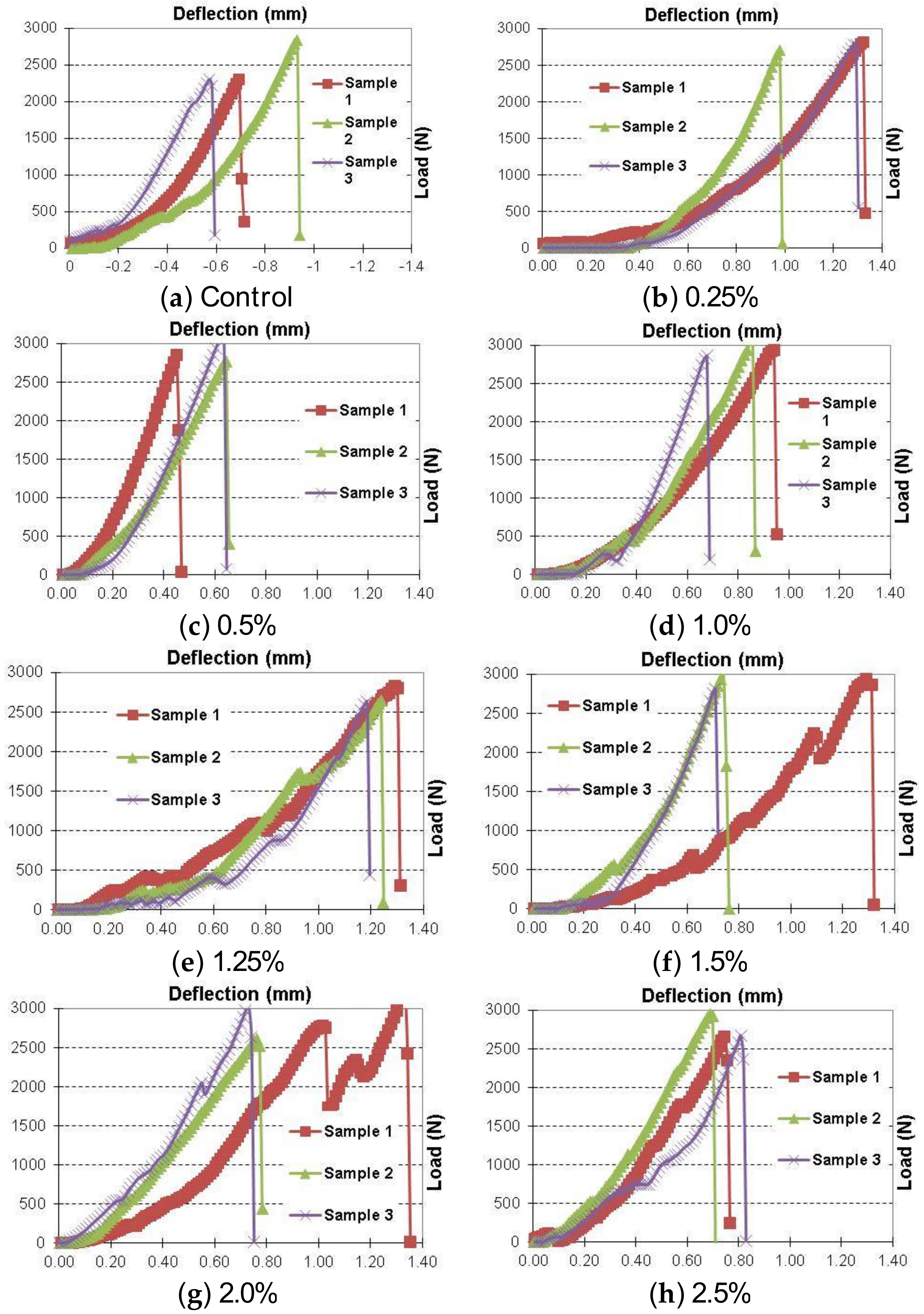
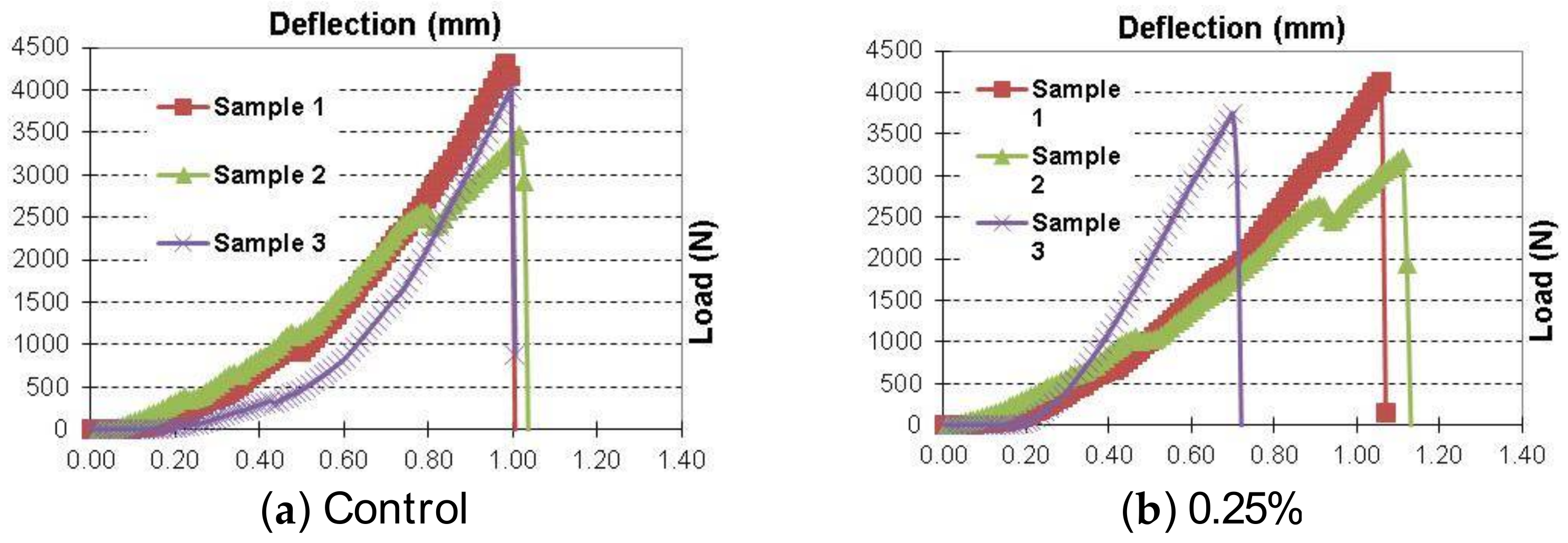

| Mix ID | Portland Cement (kg/m3) | Sand (kg/m3) | Water (kg/m3) | SBR-Latex (kg/m3) | CNT (kg/m3) |
|---|---|---|---|---|---|
| LMM—0% | 530.2 | 1457.7 | 203.4 | 79.5 | 0 |
| LMM—0.25% | 530.2 | 1457.7 | 203.4 | 79.5 | 0.2 |
| LMM—0.50% | 530.2 | 1457.7 | 203.4 | 79.5 | 0.4 |
| LMM—1.00% | 530.2 | 1457.7 | 203.4 | 79.5 | 0.8 |
| LMM—1.25% | 530.2 | 1457.7 | 203.4 | 79.5 | 1.0 |
| LMM—1.50% | 530.2 | 1457.7 | 203.4 | 79.5 | 1.2 |
| LMM—2.00% | 530.2 | 1457.7 | 203.4 | 79.5 | 1.6 |
| LMM—2.50% | 530.2 | 1457.7 | 203.4 | 79.5 | 2.0 |
© 2018 by the authors. Licensee MDPI, Basel, Switzerland. This article is an open access article distributed under the terms and conditions of the Creative Commons Attribution (CC BY) license (http://creativecommons.org/licenses/by/4.0/).
Share and Cite
Abdel-Mohti, A.; Soliman, E.; Shen, H. Effect of Adding Carbon Nanotubes on the Freeze-Thaw and Thermal Fatigue Resistance of Latex Modified Mortar. Fibers 2018, 6, 19. https://doi.org/10.3390/fib6020019
Abdel-Mohti A, Soliman E, Shen H. Effect of Adding Carbon Nanotubes on the Freeze-Thaw and Thermal Fatigue Resistance of Latex Modified Mortar. Fibers. 2018; 6(2):19. https://doi.org/10.3390/fib6020019
Chicago/Turabian StyleAbdel-Mohti, Ahmed, Eslam Soliman, and Hui Shen. 2018. "Effect of Adding Carbon Nanotubes on the Freeze-Thaw and Thermal Fatigue Resistance of Latex Modified Mortar" Fibers 6, no. 2: 19. https://doi.org/10.3390/fib6020019





